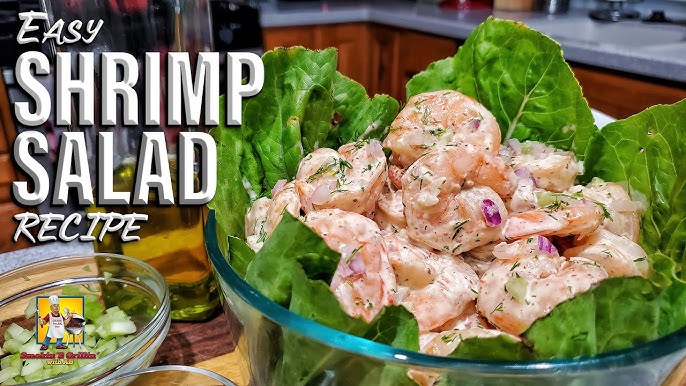Seafood Salad Recipe: Seafood salad is a refreshing, flavorful dish that combines the richness of seafood with the crispness of fresh vegetables and a zesty dressing. It’s a perfect option for light lunches, summer picnics, or even elegant dinner parties. Whether you’re a seafood lover or someone looking to add more healthy options to your diet, this recipe will not disappoint.
Packed with protein, omega-3 fatty acids, and essential nutrients, seafood salad is not only delicious but also highly nutritious. It’s easy to make and can be customized to suit your taste preferences, making it ideal for any occasion.
In this step-by-step guide, we’ll walk you through everything you need—from selecting fresh seafood to preparing the perfect dressing. So, let’s dive into the details and create a seafood salad that’s guaranteed to impress!
Ingredients and Tools Needed
Essential Ingredients for Seafood Salad
To make the best seafood salad, you’ll need the following ingredients:
- Seafood Mix (1 lb): Shrimp, crab, scallops, or squid (fresh or frozen)
- Vegetables: Cherry tomatoes, cucumbers, red onions, and bell peppers
- Leafy Greens: Arugula, spinach, or romaine lettuce
- Herbs: Fresh parsley, cilantro, and dill
- Dressing Ingredients: Olive oil, lemon juice, Dijon mustard, garlic, and honey
- Seasoning: Salt, pepper, chili flakes, and paprika
Tools and Utensils Required
- Large mixing bowl
- Sharp knife and cutting board
- Salad spinner
- Whisk for dressing
- Measuring cups and spoons
- Skillet or pot for cooking seafood
- Tongs or serving spoons
Having all these ingredients and tools ready will make the preparation process seamless and enjoyable.
Preparing the Seafood
Choosing Fresh Seafood Options
Freshness is key to a flavorful seafood salad. When selecting seafood, look for:
- Shrimp: Firm, translucent, and free of any unpleasant odor.
- Crab Meat: Pre-cooked or fresh, depending on availability.
- Scallops: Smooth and slightly shiny with a mild ocean scent.
- Squid or Octopus: Tender and cleaned, available at most seafood markets.
Pro Tip: If you’re short on time, pre-cooked seafood works well too!
Cleaning and Prepping Seafood Properly
- Shrimp: Peel and devein, removing the tail if desired.
- Crab Meat: Remove any shells and shred the meat into smaller pieces.
- Scallops: Rinse under cold water and pat dry with a paper towel.
- Squid or Octopus: Slice into rings or bite-sized pieces.
Always rinse seafood thoroughly to remove grit or debris.
Cooking Methods for Different Seafood Types
- Boiling: Ideal for shrimp and squid—boil for 2–3 minutes until opaque.
- Sautéing: Adds flavor to scallops—cook for 1–2 minutes per side in olive oil.
- Steaming: Preserves moisture—perfect for crab meat.
Once cooked, let the seafood cool completely before assembling the salad.
Making the Dressing
Key Ingredients for Dressing
The dressing brings the entire salad together, adding flavor and zest. Here’s what you’ll need:
- Olive Oil (¼ cup): Provides a rich base.
- Lemon Juice (2 tbsp): Adds freshness and acidity.
- Dijon Mustard (1 tsp): Enhances creaminess.
- Garlic (1 clove, minced): For a punch of flavor.
- Honey (1 tsp): Balances acidity with a touch of sweetness.
- Seasonings: Salt, pepper, and paprika to taste.
Steps to Prepare a Zesty Dressing
- In a small bowl, whisk together olive oil, lemon juice, and Dijon mustard.
- Add the minced garlic and honey, stirring until smooth.
- Season with salt, pepper, and paprika for a subtle kick.
- Taste the dressing and adjust flavors if necessary.
Store the dressing in the refrigerator until ready to use.
Combining Ingredients
Mixing Seafood with Vegetables and Greens
Now comes the fun part—assembling the salad!
- Start by adding leafy greens to a large mixing bowl.
- Toss in the chopped vegetables like cucumbers, tomatoes, and red onions.
- Gently fold in the cooked seafood to avoid breaking it apart.
Adding the Dressing for Perfect Flavor
- Drizzle the prepared dressing over the salad.
- Use tongs to toss everything until evenly coated.
- Garnish with fresh herbs like parsley and dill for added aroma.
Serve immediately for the freshest taste, or chill in the refrigerator for 30 minutes before serving to enhance flavors.
Serving Suggestions
Garnishing and Plating Ideas
Presentation is just as important as taste when it comes to seafood salad. Here are some creative garnishing and plating ideas to make your dish visually appealing:
- Lemon Wedges and Slices: Place lemon wedges around the edges of the plate or add thin slices on top for a pop of color and freshness.
- Avocado Slices: Add creamy avocado slices to balance the flavors and add a luxurious texture.
- Fresh Herbs: Sprinkle chopped dill, parsley, or cilantro for a vibrant, herbaceous touch.
- Microgreens or Edible Flowers: Elevate the presentation with colorful microgreens or edible flowers like nasturtiums.
- Crispy Croutons or Breadsticks: Arrange crispy croutons or breadsticks on the side for a crunchy contrast.
For plating, you can use a large serving platter, individual bowls, or even hollowed-out avocados or lettuce cups for a unique twist.
Ideal Side Dishes for Seafood Salad
Pairing your seafood salad with complementary side dishes can turn it into a complete meal. Here are some excellent options:
- Crusty Garlic Bread: Perfect for scooping up salad and soaking up any leftover dressing.
- Chilled Pasta Salad: A refreshing addition that pairs well with seafood flavors.
- Soup: A light tomato bisque or clam chowder can complement the seafood theme.
- Grilled Vegetables: Asparagus, zucchini, or bell peppers make healthy sides.
- White Wine or Sparkling Water: Ideal beverage options to balance the flavors.
Whether served as a standalone dish or part of a larger spread, seafood salad fits seamlessly into any menu.
Storage and Meal Prep Tips
Storing Leftovers Safely
Seafood is highly perishable, so proper storage is essential to keep it safe and fresh:
- Refrigeration: Store leftovers in an airtight container and refrigerate immediately.
- Shelf Life: Consume within 2–3 days for optimal freshness.
- Avoid Freezing: Freezing may alter the texture of the seafood and greens, making it less appetizing.
Tips for Meal Prepping Seafood Salad
- Prepare in Advance: Cook and chop the seafood a day ahead, storing it separately from the vegetables and dressing.
- Store Dressing Separately: Add the dressing just before serving to prevent soggy greens.
- Portion in Jars: Layer ingredients in mason jars for easy grab-and-go lunches.
Following these tips ensures your seafood salad stays fresh and delicious even when prepared in advance.
Nutritional Benefits of Seafood Salad
Health Benefits of Seafood
Seafood is packed with essential nutrients that offer numerous health benefits, including:
- High in Protein: Supports muscle growth and repair.
- Rich in Omega-3 Fatty Acids: Promotes heart health and reduces inflammation.
- Low in Calories: Ideal for weight management without sacrificing flavor.
- Vitamins and Minerals: Provides Vitamin B12, zinc, iodine, and selenium for improved metabolism and immune function.
Low-Calorie and High-Protein Features
This seafood salad is naturally low in calories and high in protein, making it a perfect dish for those following a healthy diet. Here’s a quick nutritional breakdown (per serving):
| Nutrient | Amount |
|---|---|
| Calories | 200–250 |
| Protein | 20–25g |
| Fat | 10–12g |
| Carbohydrates | 10–15g |
| Omega-3 Fatty Acids | 500–700mg |
Not only does this salad satisfy your taste buds, but it also keeps you energized and nourished.
Customization Ideas
Substitutions for Ingredients
Don’t have all the ingredients on hand? No problem! Here are some quick substitutions:
- Seafood: Swap shrimp for lobster, crab for imitation crab, or add grilled salmon chunks.
- Greens: Replace arugula with kale, spinach, or mixed salad greens.
- Vegetables: Add roasted corn, shredded carrots, or radishes for extra crunch.
- Dressing: Use Greek yogurt with lemon juice for a creamy alternative.
Vegan and Vegetarian Alternatives
For a plant-based version, try these swaps:
- Seafood Substitute: Use marinated hearts of palm, artichoke hearts, or grilled tofu.
- Plant-Based Dressing: Replace honey with maple syrup or agave nectar.
- Protein Boost: Add chickpeas, edamame, or quinoa to maintain protein content.
With these variations, you can tailor the salad to meet dietary preferences or restrictions without sacrificing taste.
Expert Tips and Tricks
Enhancing Flavor with Herbs and Spices
- Citrus Zest: Grate lemon, lime, or orange zest for an extra layer of flavor.
- Spice it Up: Add a pinch of cayenne or chili flakes for a mild heat.
- Fresh Herbs: Incorporate basil, thyme, or chives for added aroma.
Avoiding Common Mistakes in Seafood Salad Preparation
- Overcooking Seafood: Cook seafood just until opaque to prevent rubbery texture.
- Overdressing: Add dressing gradually to avoid a soggy salad.
- Skipping the Chill Time: Let the salad rest in the fridge for 20–30 minutes to meld flavors.
These tips ensure a foolproof, flavorful seafood salad every time.
FAQs about Seafood Salad Recipe
1. What types of seafood can I use for a seafood salad?
For a seafood salad, flexibility is key. Common choices include shrimp, crab meat, scallops, and squid. You can use fresh, canned, or frozen seafood, depending on availability and preference.
2. What are some good vegetables to add to a seafood salad?
Crisp vegetables like celery, cucumbers, and bell peppers add texture and freshness. Avocado, tomatoes, and onions are also popular for their flavor complementing the seafood.
3. What dressing works well with seafood salad?
A light dressing is usually best. Lemon vinaigrette, olive oil with herbs, or a creamy dill dressing enhance the seafood without overpowering it. Adjust seasoning to taste, keeping it simple to let the seafood shine.
4. How can I ensure my seafood salad is safe to eat?
Use fresh seafood and prepare it on the same day you plan to serve the salad. If using frozen seafood, ensure it is thoroughly defrosted and cooked properly before mixing with other ingredients.
5. Can I make seafood salad ahead of time?
It’s best to make seafood salad fresh. However, if you need to prepare it ahead, store it in the refrigerator and consume within 24 hours. Keep the dressing separate until ready to serve to maintain the best texture and freshness.
Conclusion
With easy preparation steps, nutritional benefits, and endless customization options, this seafood salad is sure to become a staple in your kitchen. Remember to use the freshest ingredients, follow proper storage tips, and take advantage of the expert tricks shared here to make your salad taste amazing every time.
So, gather your ingredients, prepare the dressing, and dive into creating a seafood salad that not only satisfies your taste buds but also leaves a lasting impression on your guests. Enjoy your culinary journey!



